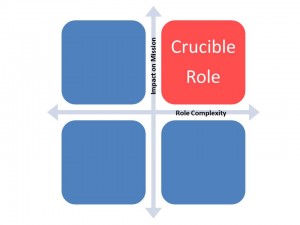 Before you can develop the talents of your high potential employees, you first have to be able identify these employees. That’s where crucible roles come into play. Crucible roles help you determine the employee’s level of aspiration. High potential employees must also demonstrate superior abilities and engagement.
Before you can develop the talents of your high potential employees, you first have to be able identify these employees. That’s where crucible roles come into play. Crucible roles help you determine the employee’s level of aspiration. High potential employees must also demonstrate superior abilities and engagement.
Ability: Create a list of innate characteristics (mental agility and emotional intelligence) and learned skills (technical, interpersonal, and functional) that your organization believes to be critical in nature, as a whole and to a specific leadership role. Once you have established this list, see how employees measure up.
Engagement:
- Does the employee value the organization?
- Does the employee believe that staying with the organization is in their own self-interest?
- Does the employee often “go the extra mile”?
- Do you believe that the employee is going to stay?
If the answer to all of these questions is a definitive “Yes,” the employee is a prime candidate for a leadership position.
Aspiration: Not everybody in the organization will aspire to take on senior leadership roles. Not even your top performers will aspire to be in senior roles. In many instances, top performers are the wrong selection for leadership roles. They want and probably ought to stay where they are thriving.
Crucible Roles
Once you have identified individuals that you and your organization believe are high potential leaders, provide them with roles or projects that test their mettle. These crucible roles are intended to be stretch assignments: high in complexity and critical to the success of the organization. These crucible roles are critical to developing ordinary employees into extraordinary leaders.



